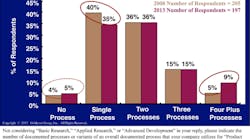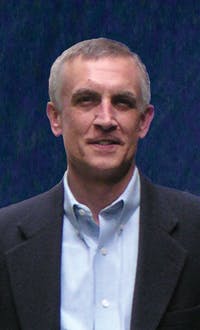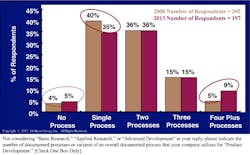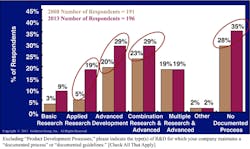Design engineers, program managers, and organizational leaders are likely seeing an increase in processes used to guide research and development. GGI has researched the subject since 1998 and we’ve seen a new wave of them the past five years, spurred by the need for western companies to improve their innovation to compete.
The change is not as pronounced for Product-Development processes. In 2008, 76% of companies had one or two processes to guide development projects. Forty percent of companies used one process and 36% used two. This year, the number of companies running with a single process decreased to 35% as companies added more processes. Most notably, the number of North American companies using four or more processes nearly doubled.
Historically, European companies have always used four to five processes such as new platform, platform derivative, regular new product, product extension, and cost reduction or value engineering as representative categories. The reasons for the slight rise in North American processes are unclear. It is hard to believe North American leaders actively guided their companies toward more processes. We believe the increase stems from the evolution of globalization. More European companies are operating in North America and it appears to be affecting product-development processes.
For preproduct-development processes, the change is pronounced. Older folks remember when there was little or no structure to activities preceding product development. It was not really fair to SMEs, research scientists, and fellow-level engineers, but their work was referred to as being in the “sandbox.” Management, in many mechanical/electrical/electronic industries, always worried about funding levels because they could not track or oversee funds invested in these areas.
Enter the mantra of innovation in the early 2000s and a decade later, these earlier activities get more funds as a way to obtain higher and repeatable levels of innovation, and the sandbox is no more.
Our 2008 research indicated meteoric growth in activities preceding product development. It is clear that companies became more conservative in their portfolio to turn out products which would have fairly certain sales. At the same time, it appears in 2013 the sandbox funding, which might have been wiped out in previous recessions, is now too important to be negated. That’s because innovation can no longer take a back seat, even in difficult economic times.
Over the past five years, there has been a tripling in formal basic-research processes and a near quadrupling of formal Applied-Research processes. Advanced-Development processes have risen 30%. A number of companies have “combination processes” used across several categories and those numbers have also risen.
For designers and practitioners in research and product development, more-formalized processes are often seen as hassles and possibly even impediments to creative freedom. From a job-security view, management’s formalization of innovation processes is likely a positive. There is clearly more corporate commitment to innovation that transcends the “fund again-cut again” approach to the sandbox in good and bad economic times.



